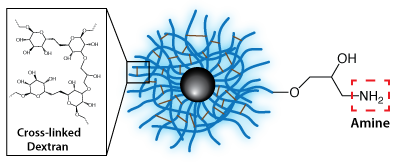Luna Nanotech is happy to introduce our new in vivo ready NanoVIVO™ Magnetic CLIO Nanoparticle Line. Dextran coated magnetic cross-linked iron oxide nanoparticles (CLIO) have superparamagnetic Fe3O4 iron oxide cores (8-10 nm in diameter) imbedded within the matrix of dextran sugar strands of 40 or 70 kDa in size. Dextran strands are cross-linked to prevent their disassociation, ensuring long-term stability during storage and in biological fluids, such as blood. Due to the dextran sugar coat CLIO particles are highly biocompatible and have a long blood half life. Overall CLIO nanoparticle diameter ranges between 65 nm and 110 nm, making them optimal for in vivo applications.
CLIO nanoparticles are available with a variety of surface chemistries that can be used for bioconjugation of biological ligands for a range of biomedical applications:
Biomolecules containing activated NHS ester or a carboxylic acid can be easily conjugated to amine functionalized CLIO nanoparticles through EDC/NHS chemical reaction.
Strong Biotin-Streptavidin interaction can be used to easily load Antibodies or other biomolecules onto the Streptavidin and Biotin functionalized CLIO nanoparticles.
Fluorescently labeled CLIO nanoparticles can be used as dual magnetic and fluorescence imaging and MRI probes for in vitro assays and for in vivo nanoparticle tracking. When combined with Antibodies loaded through the Biotin-Streptavidin interaction, CLIO nanoparticles can be used to target specific cells and tissues in vivo, or for development of in vitro bioassays.
CLIO nanoparticles functionalized with antibodies through Biotin-Streptavidin interaction can be used as dual probes for magnetic cell separation followed by flow cytometry analysis or fluorescence associated cell sorting (FACS).


Luna Nanotech would like to thank Canadian Israel Industrial Research and Development Foundation (CIIRDF) for providing financial assistance that was critical for the development of the NanoVIVO™ Magnetic CLIO Nanoparticle Line.





